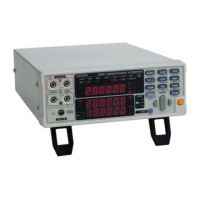173
Appendix 4 Effect of Thermoelectromotive Force
Thermoelectromotive force is the potential difference that occurs at
the junction of two dissimilar metals, which if sufficiently large, can
cause erroneous measurements. Because this instrument functions
by measuring potential difference while applying a constant direct
current through the test object, the effect of thermoelectromotive force
can affect measurements. The amplitude of thermoelectromotive force
depends on the temperature of the measurement environment, with
the force generally being greater at higher temperature.
Thermoelectromotive force typically occurs at any junction of
dissimilar metals, including between the test probe tips and the test
object.
The following diagram illustrates thermoelectromotive force.
Measurement discrepancy caused by thermoelectromotive
force:
Example If the amplitude of electromotive force is 10 µV and the resistance to
be measured is 2 Ω, the measurement current of the LP 2Ω range is
10 mA, and
the actual measured value displayed on the instrument is as follows:
(2 Ω x
10 mA + 10 µV) ÷ 10 mA = 2.00100 Ω
The effect of this thermoelectromotive force can be suppressed by
enabling this instrument's Offset Voltage Compensation (OVC)
function.
In the 2Ω range and higher, a measurement R
ON
is first taken with
measurement current on, then the current is switched off and another
measurement R
OFF
is taken, with the true measurement value
calculated by R
ON
− R
OFF
for display.
In the 20mΩ and 200mΩ ranges, the following value is displayed as
the true resistance obtained from the value R
P
(>0) measured with
measurement current flowing in the positive direction and the value
R
N
(<0) measured with measurement current flowing in the negative
direction.
(R
N
is a negative value)
Appendix 4 Effect of Thermoelectromotive
Force
3541
Metal A Metal B
Thermoelectromotive
force
R
p
R
N
–
2
-------------------

